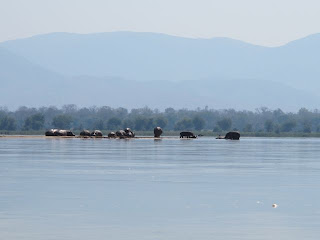 |
| Flight over Zambia |
| Linkuvasha Bush Airstrip |
Zambezi River Paradise
It is June 27th as I write this entry, sitting at the edge of the Zambezi River in the remote luxury of Ruckomechi Camp. This segment of our adventure began yesterday when after breakfast at Davidson Camp, we were transported an hour to the remote airstrip, Linkuvasha, for our flight here.
The morning’s temperature is 1 degree centigrade as we huddle around the fire circle, holding tin mugs of hot coffee, warming our extremities and waiting to depart Davison Camp. At 8:00 A.M. bundled warmly, we bump along the rutted dirt road to catch our plane. Upon arriving, Brian our guide races our vehicle along the grassy airstrip to clear the runway of a flock of ground hornbills in preparation for the incoming plane. We wait patiently, soaking in the morning sun and enjoying the solitude when our vehicle’s radio sputters to life. Our plane has been delayed an hour, so in the interim, we hop back into the vehicle and Brian takes us on a short game drive. Returning to the Linkuvasha airstrip we watch as a small silvery speck in the sky takes the shape of a tiny bush plane and lands on the grassy runway. After brief farewells, we climb onboard the 4 seated air plane and are immediately bumping along the runway for takeoff. We are the only passengers and we catch our breath as the small plane lifts off, shudders, banks, and stabilizes. The teak and acacia forest below becomes a melody of fall colors and as we gain altitude, I see the curly grey smoke from many forest fires clouding the horizon. The landscape soon changes from sparse forest to a patchwork of monochromatic farm land and I am lulled by its monotony. Initially, our pilot busies himself with control dials and radio, and I am beginning to relax until I realize that he has begun texting on his Nokia cell phone and is paying little attention to our flight path. An hour and a half later, we land safely at the tiny airport of Kariba to refuel. John and I enter the bleak terminal to use the facilities and John gazes longingly through the closed grill of the snack stand at several ancient and certainly stale packages of cookies. The second leg of the trip takes just 30 minutes and the flight is spectacular. The ground below is sculpted by canyons and dry curving river beds and when we reach the Zambia River we fly low along the river, a maze of islands, lagoons and marshlands, studded with pods of hippos.











